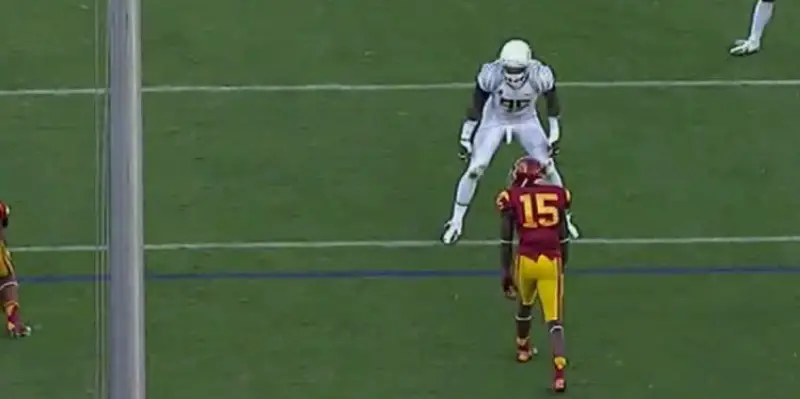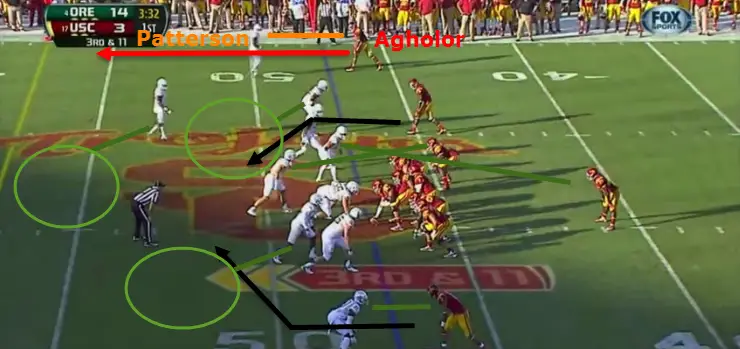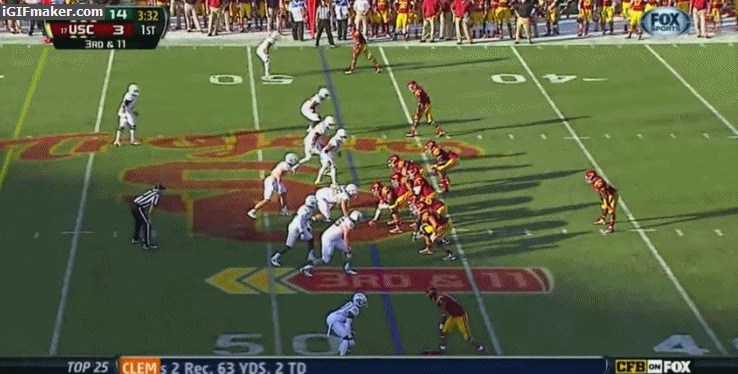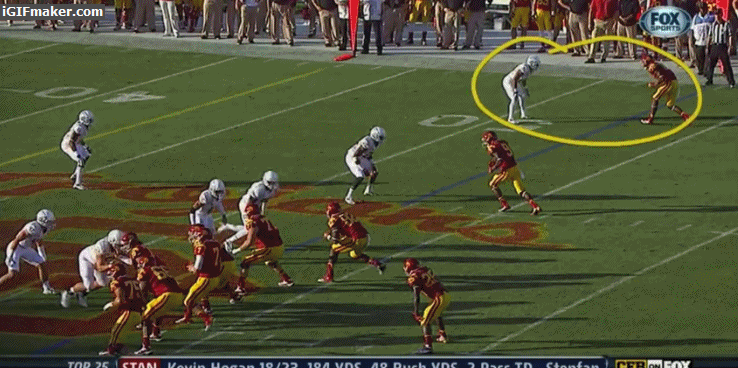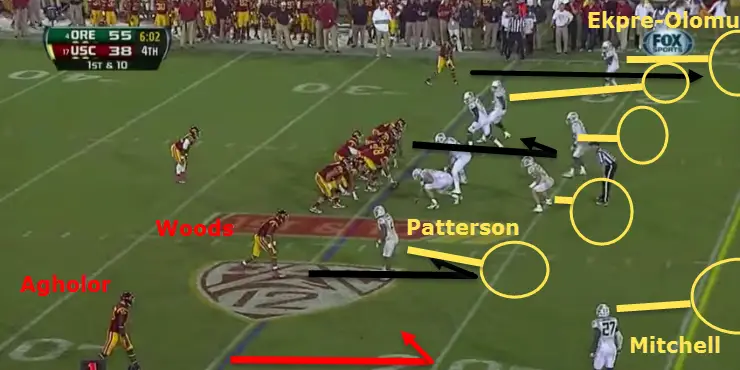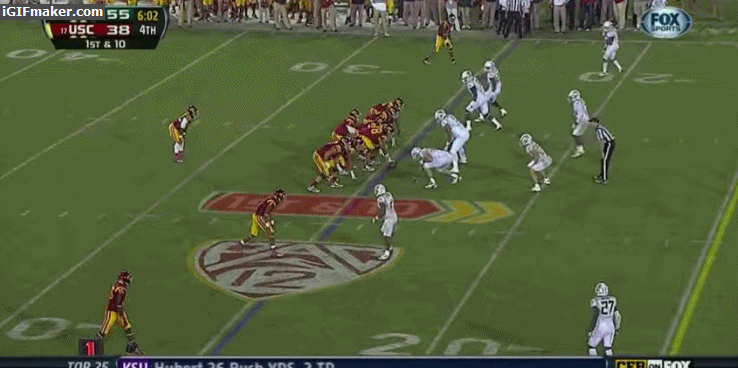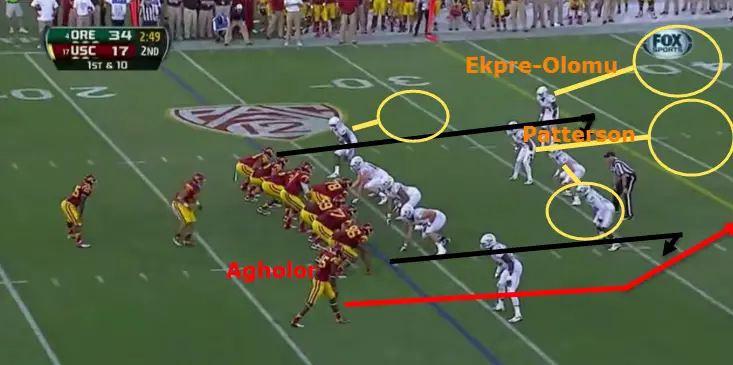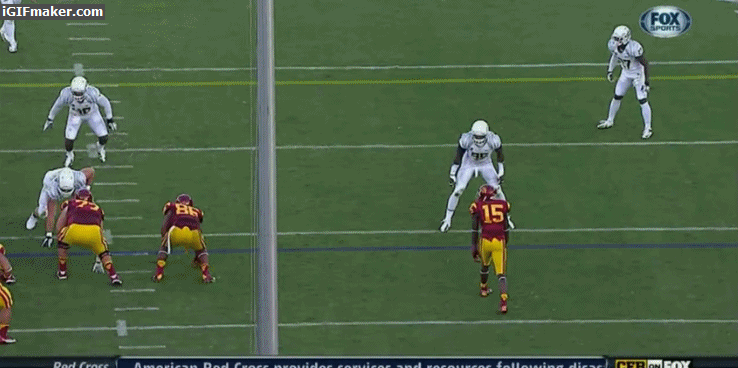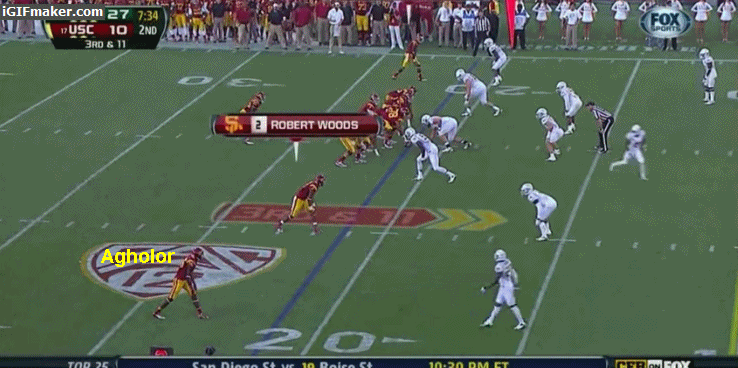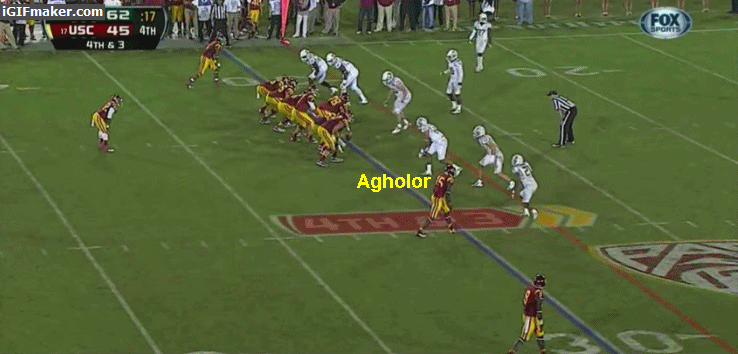When it comes to the NFL Draft, Chip Kelly heeds the advice of Horace Greeley: “Go West, young man.” In Kelly’s three seasons as the Philadelphia Eagles head coach, the team has used nine of its 21 draft picks on Pac-12 prospects.
For this reason, it was unsurprising that Kelly decided to go west with USC receiver Nelson Agholor in the first round of the NFL Draft. Like past Kelly draft picks Zach Ertz and Matt Barkley, Agholor gashed Kelly’s Oregon defense when he had the chance. As a freshman in 2012, Agholor made six receptions for 162 yards and a touchdown against Oregon. Many of the traits Kelly admires in Agholor were already evident at that game.
Vertical Threat
Since Jeremy Maclin left in free agency, Kelly needed a receiver who could replace his production in the vertical passing game. Agholor is exactly what the doctor ordered.
USC head coach Lane Kiffin tasked Agholor with a go route (red arrow) down the sideline on this play (above). The coach counted on Agholor’s speed to beat Oregon defensive back Avery Patterson (orange line).
Kelly staunchly believes that beating man coverage is the sign of a reliable receiver. The USC receiving corps included other heralded prospects like Robert Woods and Marqise Lee, so Kelly and defensive coordinator Nick Aliotti put the cornerbacks in press man position near the line of scrimmage. The Ducks showed Cover 1 on this play with a single high safety (not shown) behind the corners.
Agholor pivoted subtly to run around Patterson on this play (above). Deep safety Erick Dargan (No. 4) could not provide help because Agholor beat Patterson so suddenly.
It remains a question whether Agholor has the necessary physicality to defeat pro cornerbacks who excel at man coverage. Pro cornerbacks will rarely react as slowly as Patterson when they press, but this play speaks to Agholor’s potential regardless.
According to phillymag.com, Kelly said, “So anybody we’re gonna look at at wide receiver from the future here on or that’s currently on our roster is: What’s your ability to get open in one-on-one coverage? Because we see a ton of it. That’s a huge thing for us in the offseason.” On that basis, Agholor passed Kelly’s test with flying colors.
Run After Catch Ability (RAC)
Getting open downfield produces big plays, but gaining yards after short catches can do this too. Tommy Lawlor of IgglesBlitz rightfully praised Agholor for having both skills: “Agholor is a good fit for the Eagles offense. He has the speed to be a deep threat, but also has terrific RAC skills. The WR corps had some talent, but needed someone with top speed and RAC skills.”
Kiffin had a good play design (above) against the Ducks’ coverage, which Agholor exploited with his RAC ability. The Ducks were in Cover 4, as the outside cornerbacks dropped into deep zones and split the deep field into quarters with two safeties. Agholor (red arrow) ran a quick hitch, while Terrance Mitchell (No. 27) retreated immediately.
Agholor smoothly pivoted up and to his left for an easy catch. Agholor used the space in front of him to cut inside the “alley” between Patterson and Mitchell. His speed and fluidity allowed him to avoid getting tackled near the spot of the catch, resulting in ten yards after catch. Whether he is on a go route or quick hitch, Agholor is a big play waiting to happen.
Superb Concentration
A big problem many receiver prospects struggle with is dropping passes or making a catch in tight coverage. At an early stage in his development, Agholor showed the mental ability and physical toughness to make tough catches.
In Cover 3 for this play (above), the Ducks split the back of the field into thirds with Ifo Ekpre-Olomu, Patterson, and Mitchell (not on screen) taking a deep zone. Agholor was assigned to run a deep post and needed to get some separation on Mitchell.
Kelly and Eagles defensive coordinator Billy Davis frequently use Cover 3 in their own scheme to allocate extra defenders in deep zones. Moreover, Kelly’s offense extensively faced Cover 3 last season because it is designed to limit the big plays characteristic of the Eagles. The play which unfolded below signaled to Kelly that he could have a weapon to beat this coverage.
Mitchell did a good job mirroring Agholor, who made his cut ten yards downfield. Agholor ran fast enough to get behind Mitchell, though he did not do so with significant separation. If combined with Agholor’s impressive speed, moves like a head fake or juke would have created a wide throwing lane over the middle against this Cover 3 look.
Still, Agholor kept his eyes on the ball the whole time despite tight coverage. The truly impressive part of this play is how Agholor snatched the ball with two hands away from his body. While the nuances of creating separation might have been raw for Agholor, his concentration resulted in the big play Cover 3 is designed to prevent.
Adequate Blocking
The idea that blocking should be a criterion on which receivers are judged might seem perplexing to the casual fan. To Kelly, however, blocking is not optional. “I think he treats it differently,” Josh Huff said, according to nj.com. “In college, if you don’t block, you don’t get the rock.”
Agholor is not particularly strong, but he consistently makes an effort to block defenders. On this play (above), he and Woods executed double posts (a concept Kelly has frequently used in Oregon and Philadelphia), while Lee caught the ball on a curl route. While Lee broke free, Agholor looked for a defender to block and found Patterson (No. 21). It was not a particularly impressive block, but it was just enough to keep Patterson out of the play.
Kiffin called for Woods to run a five yard drag route over the middle on this play (above), while Agholor and Lee were sent downfield on the backside. After Woods shed a tackle, he ran behind the other two receivers who could block for him. This time, Agholor’s block on Dargan (No. 4) opened a lane for Woods to gain ten extra yards. Agholor’s blocking might not put the fear of God in defenders or rival the wrath of Josh Huff, but the effort has value nonetheless.
Conclusion
Kelly had already recognized Agholor’s talent when he tried to recruit the Tampa, Fla. native to play for Oregon. As the breakout game of Agholor’s college career, the 2012 USC-Oregon game validated Kelly’s preconceptions of the receiver. The film of Agholor in this game showed — even back in his freshman season — he had the makings of a productive receiver in Kelly’s offense. Kelly knows firsthand the damage Agholor can inflict on opposing defenses. Now, this weapon belongs to him.
I may be in Pennsylvania, but “Oh how we love to learn about your beloved Ducks!”
Joe Kearns
Oregon Ducks and Philadelphia Eagles Football Analyst for CFF Network/FishDuck.com
State College, Pennsylvania
Top photo from video
Joe Kearns is a senior at the Pennsylvania State University majoring in Economics. He intends to pursue a career in the banking and financial services industries, but is also a lifelong diehard Philadelphia Eagles fan who enjoys analyzing college and pro football film as a hobby. Along with being a fan, Joe’s football knowledge comes from his days as a center, defensive tackle, and long snapper for his high school in Mt. Lebanon, Pa. Though he is a Nittany Lion, he has taken a great interest in the Oregon football team since Chip Kelly became the Eagles head coach. He loves pancakes ( and not just the breakfast food).

